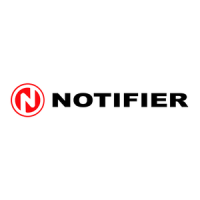INA 15092:I 05/30/01
31
BACK
SPACE
➪
ABOUT THE PRINT TIME
Output from the printer for a particular event (alarm, trouble, acknowledgment, etc.), includes the time the event was sent
to the printer, which in most cases is identical to the time the event occurred. In extreme cases, when many events have
occurred within a few seconds, the time printed for a particular event may differ from the actual event time by up to one
minute. After events have been acknowledged, only the event history buffer (which may be printed) and the system printer
will provide a record of the time at which events occurred.
ABOUT PRIORITIES
Every AM2020/AFP1010, AFP-300/400 and AFP-200 event the INA displays is prioritized. Security alarms will increment
the trouble counter on the terminal status line of the CRT. The INA processes and displays AM2020/AFP1010, AFP-300/
400 and AFP-200 events under the following priorities (the highest priority is displayed first and the lowest priority is
displayed last).
1) Fire Alarms 9) Cleared Fire Alarms
2) Security Alarms 10) Cleared Security Alarms
3) Supervisory Signals 11) Cleared Supervisory Signals
4) Device Troubles 12) Cleared Device Troubles
5) Disabled Zones 13) Cleared Disabled Zones
6) System Troubles 14) Cleared System Troubles
7) Annunciator Troubles 15) Cleared Annunciator Troubles
8) Local INA Troubles and 16) Cleared Local INA Troubles and
Remote INA and NRT Troubles Remote INA and NCS Troubles
In addition, detectors have a higher priority than modules within each detector/module category; the lower the address, the
higher the priority (see list below). The display of certain events can be preempted by others at the time they are acknowl-
edged. Pay careful attention to the display when acknowledging events. The Node Address will determine priority only if
the same event on the same point occurs on multiple nodes. In that case, the event on the node with the lower node address
has the highest priority.
Node 1, Loop 1 Detector 1, Loop 1 Detector 2, Loop 1 Detector 3 . Loop 10 Detector 99 (followed in priority by)
Node 1, Loop 1 Module 1, Loop 1 Module 2, Loop 1 Module 3 . Loop 10 Module 99 (followed in priority by)
Node 1, Zone 1, Zone 2, Zone 3 . Zone 240 (followed in priority by)
Node 1, System Trouble Indication (in Hex) T00, T01, T02 . TFF (followed in priority by)
Node 1, Annunciator Trouble Indication (in Hex) N00, N01, N02 . . NFF
ABOUT THE BACKSPACE KEY
The Backspace key serves two purposes:
1. At a menu prompt, pressing "aborts" the selection of that menu.
2. When entering data or making a selection from a menu, pressing erases the last character, or menu
choice entered.
➪
BACK
SPACE
ABOUT ADDRESSES
For certain functions such as READ STATUS, the operator must enter a device, software zone, or annunciator point
address. Leading zeroes are not required. The address assumes the following format:
LXX(D/M)YY, ZXXX or AXXPYY
Annunciator Point
Enter "A" followed by 1 to 32 for the an-
nunciator module address, then "P" fol-
lowed by the module point 1 to 64.
SLC Loop Device
Enter "D" for an intelligent detector or "M" for an
addressable module followed by an address in
the range 1 to 99.
Software Zone
Enter "Z" followed by 1 to 240.
SLC Loop
Enter "L" followed by 1 to 10 for AM2020.
Enter "L" followed by 1 to 4 for AFP1010.
www.PDF-Zoo.com

